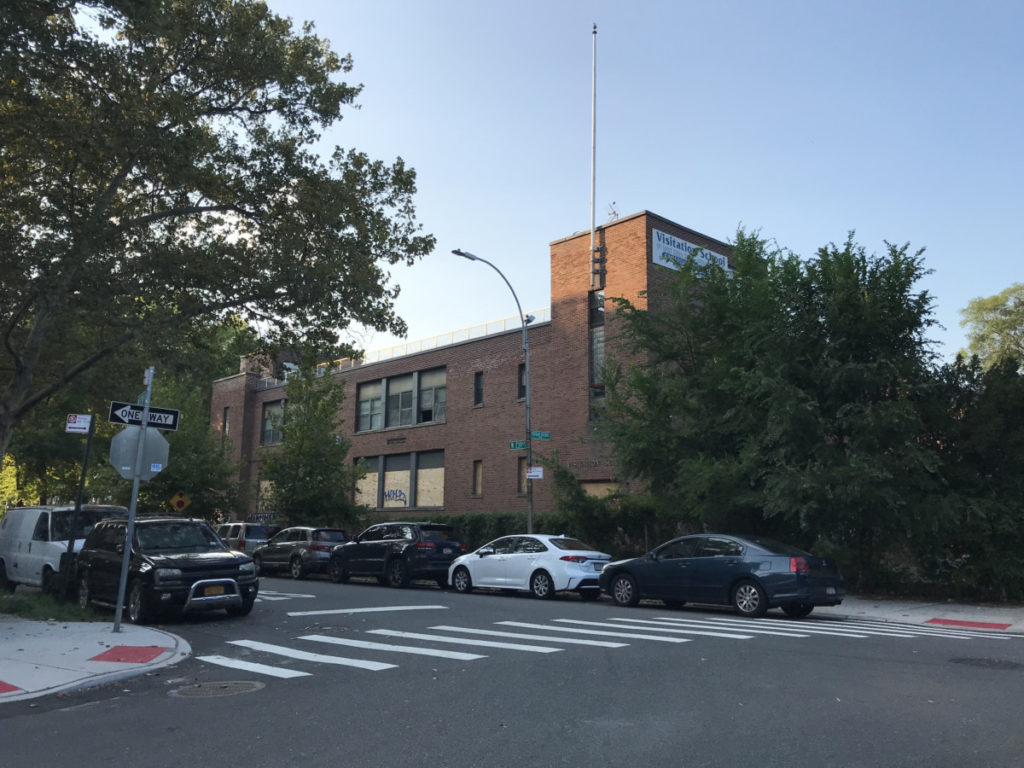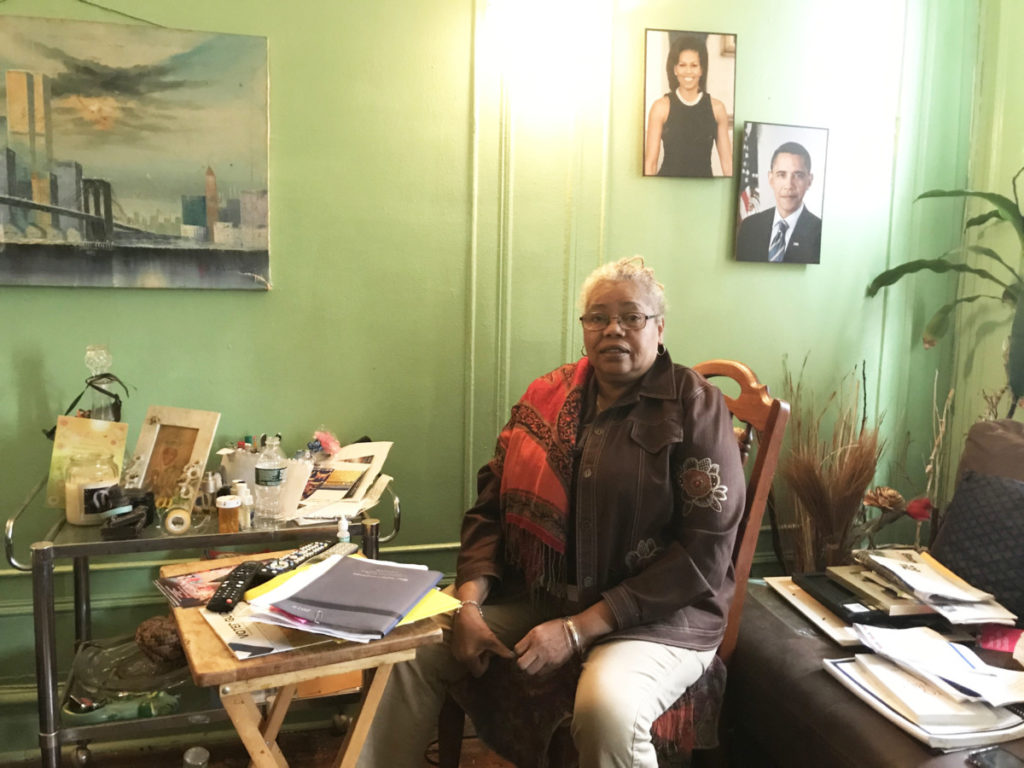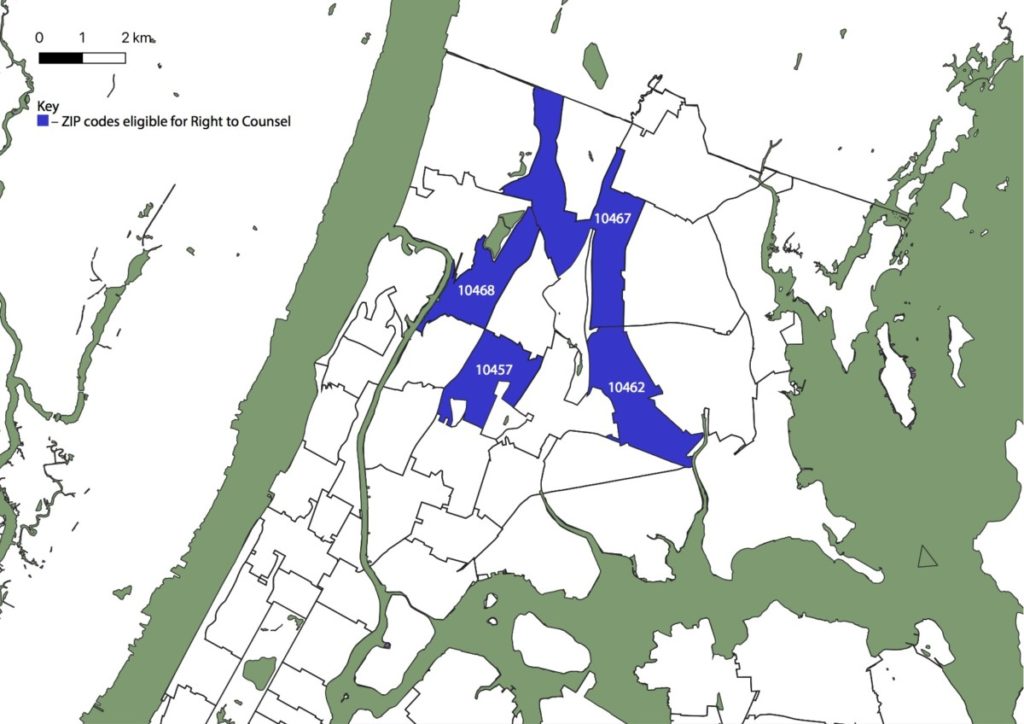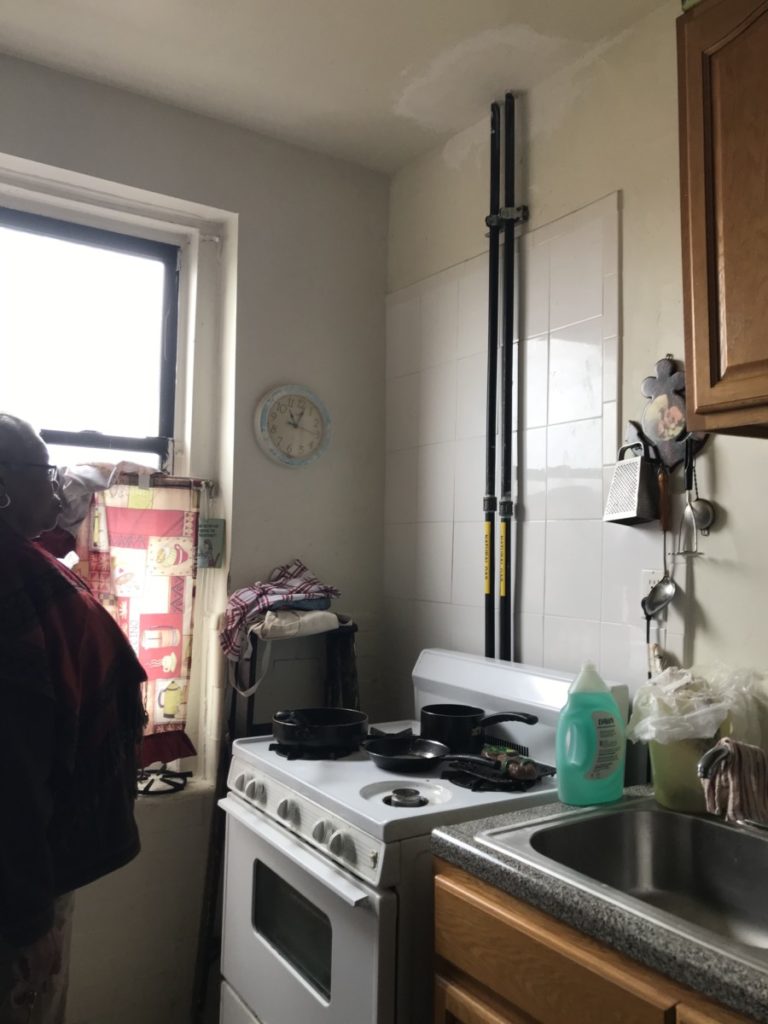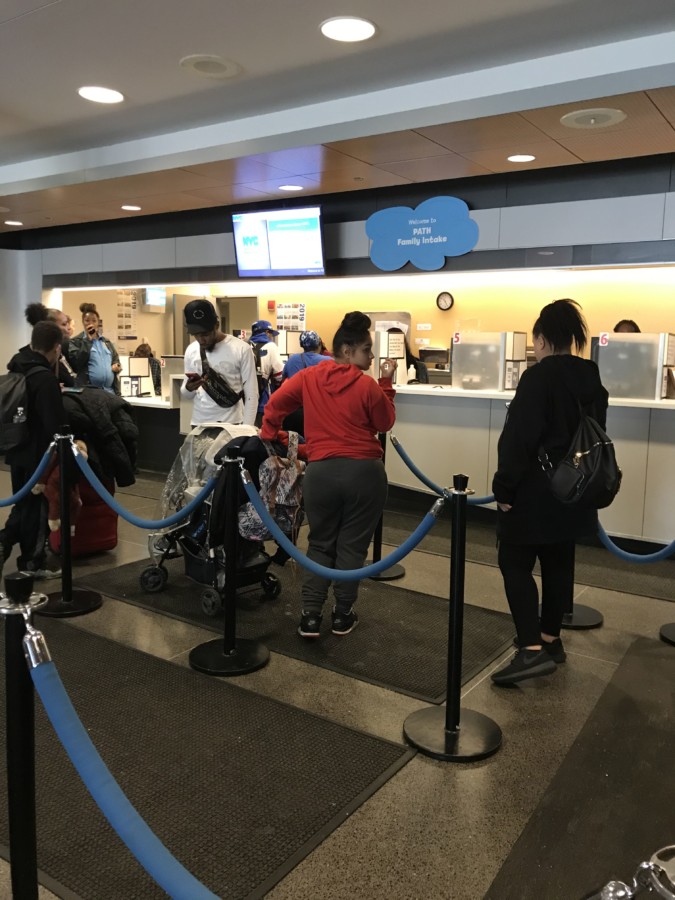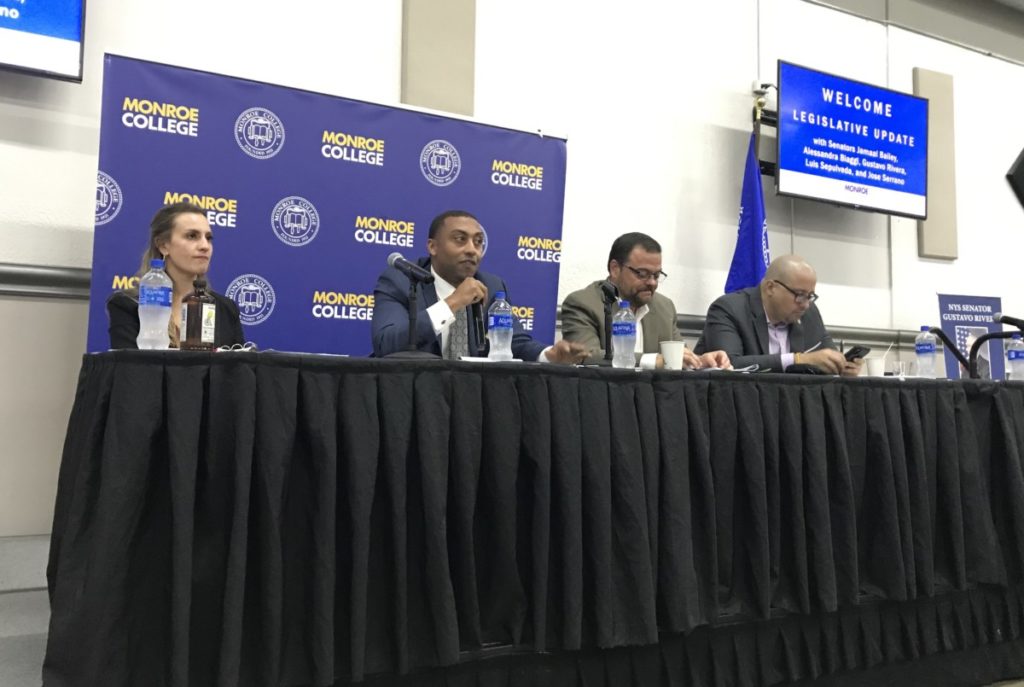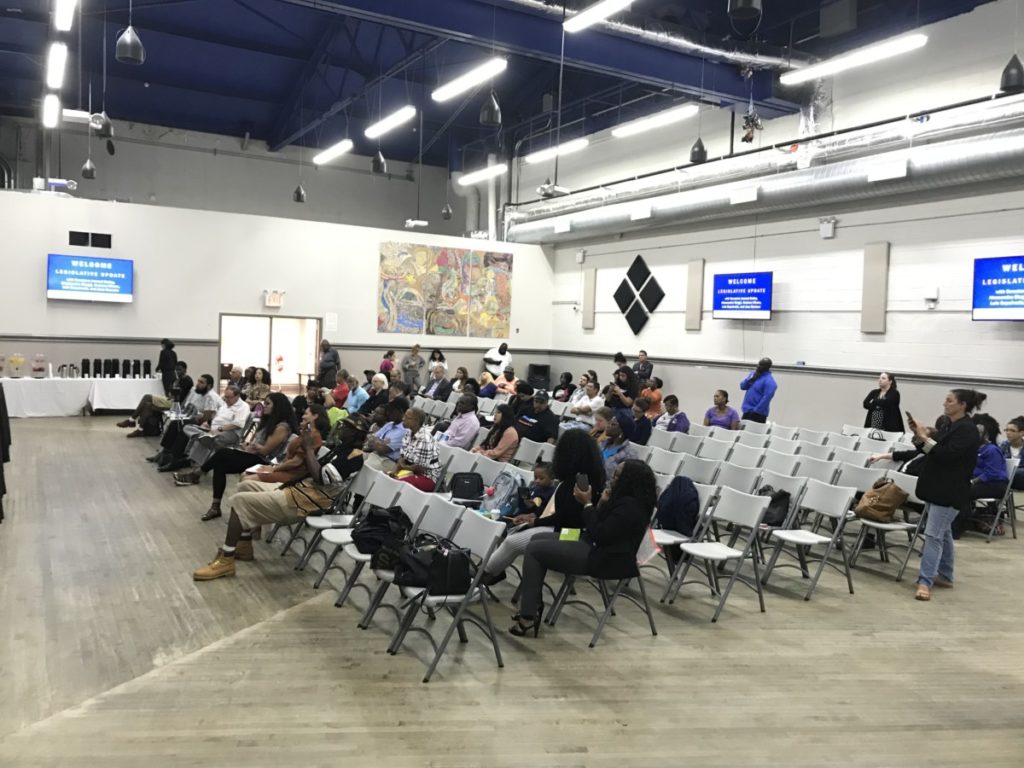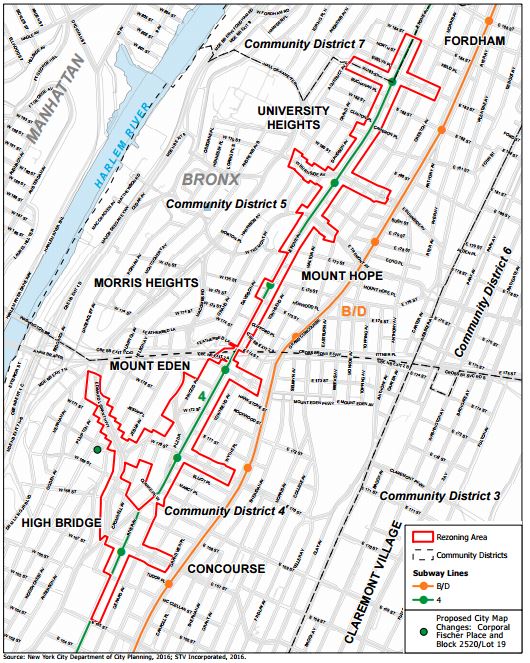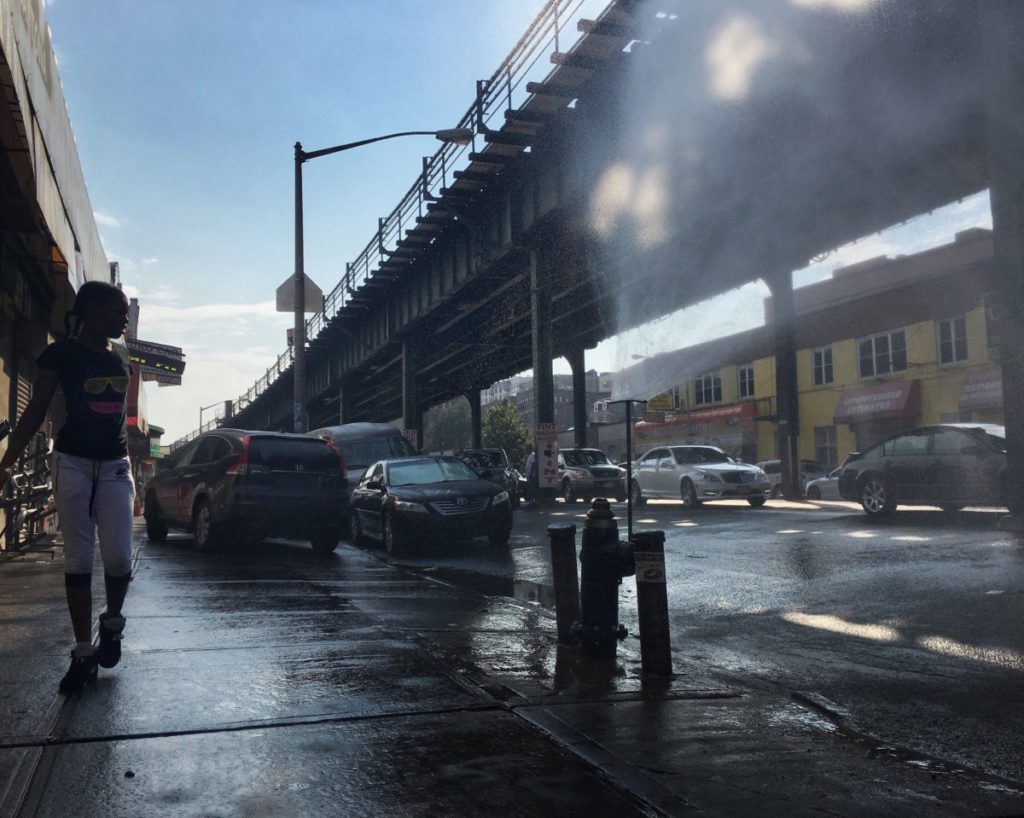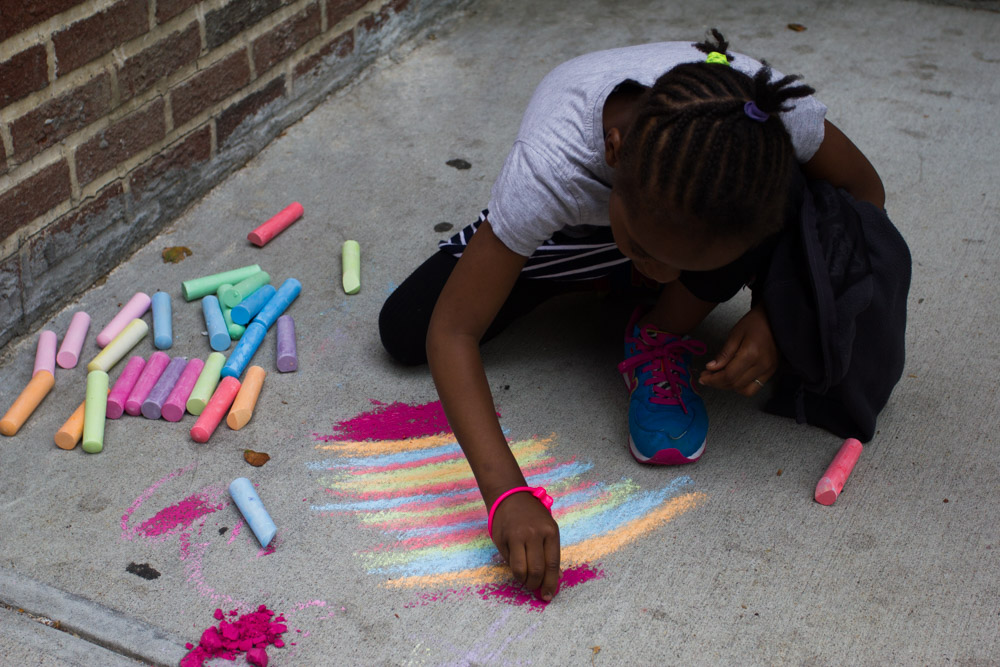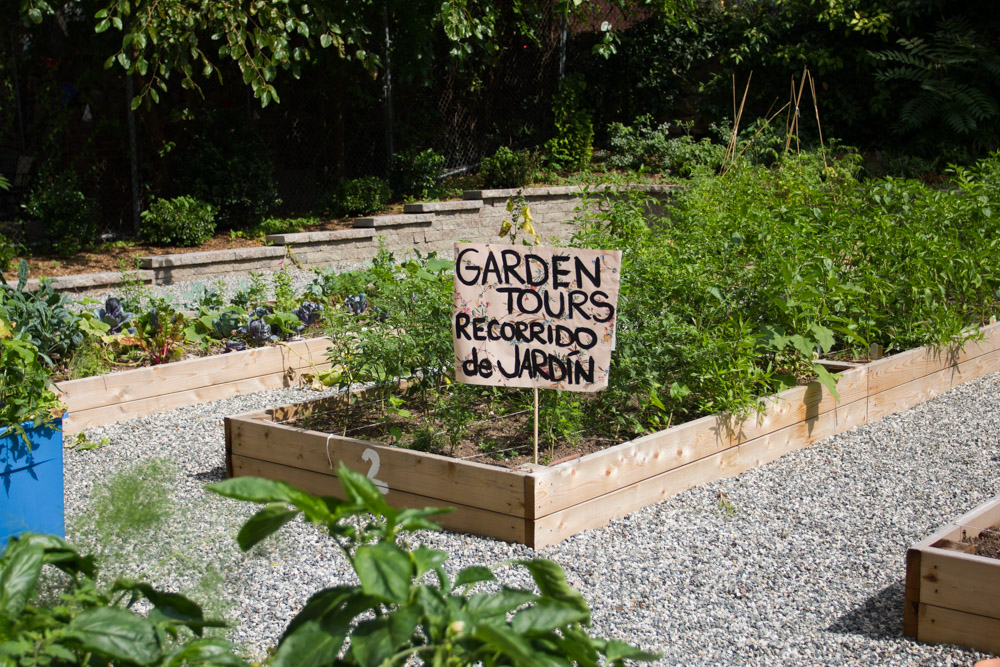
The Brook, an affordable housing complex located at 455 East 148th St., offers 190 units to people with mental health problems and low-income residents. (MARIANA IONOVA / The Bronx Ink)
Edgar Gamble has everything he needs packed into 250 square feet of living space. His compact home includes a bed, a small bathroom and a partial kitchen. His window looks onto a leafy, tidy courtyard. A miniature walk-in closet tucked in the corner of the bedroom would be the envy of most New Yorkers. All of it costs him $600 per month and it certainly beats his last address: a shelter for homeless veterans.
The 49-year-old ex-Marine lived on the street for nearly five months before residence management approved him for a unit at The Brook, a nonprofit supportive housing development providing single-room homes in the Mott Haven section of the Bronx. The 190-unit nonprofit complex was built just three years ago. It has a shiny, pale grey exterior, which stands out next to the neighboring crumbling brownstones with facades slashed by strings of colorful laundry hung onto fire escapes.
The luxury of the Brook is an anomaly in the world of single-tenant homes, which often offer cramped quarters the size of a parking space. Gamble, who recently got hired as a blood laboratory specialist at Bronx Lebanon Hospital, has lived in about a half dozen single-unit homes in specialized Single Room Occupancy (SRO) residences since he left the Marines. Most lacked cooking facilities and extra space was unthinkable. “If you were lucky, you got a room with a bathroom,” he said. “If you got it, it was smaller than a jail cell.”
About 30,000 of these legal SRO units exist in New York City today and they account for only about 8 percent of the housing market. The city defines them as one-bedroom dwellings that usually share bathroom or kitchen facilities with other units. Rooms must be at least 150 square feet and each one has to have a window, city regulations say. All rooms must have access to a fire exit and only tenants over 16 are allowed to occupy them. Owners usually collect the rent each week, charging each tenant somewhere between $100 and $200.
While today single room units are a sliver of the city’s real estate, this wasn’t always the case. Researchers estimate that, in the 1950s, approximately 200,000 units existed in New York City. But in 1955, the city, motivated by a deep belief that cramped single rooms offered substandard conditions, banned further construction of new SRO residences. The idea was to phase out poor housing and replace it with better-quality dwellings, said Brian Sullivan, an attorney with the SRO Project at MFY Legal Services, a nonprofit firm that represents low-income tenants in housing claims.
“The problem is that the people of the ’50s imagined everyone would prosper and be able to afford good housing,” he said. “So the number of legal SROs plummeted catastrophically over the last 50 years, without any real sense of alternatives.”
The response has been a boom in illegal single room units, which have been springing up outside the city’s regulatory reach with unprecedented speed. City officials say that owners of one- and two-family houses are illegally chopping up their homes to convert them into multiple-unit dwellings that can be rented out to desperate tenants looking for low-cost housing. These homes are often crowded to the point of exceeding city regulations and rooms lack access to proper fire exits, posing a serious risk to tenants.
Francisco Gonzalez, manager of Community District 9, said illegal single units in the Bronx in particular have been on the rise in the last two years, as more new immigrants looking for cheap housing have moved into the borough. The increase in his district has been mostly around Boynton and Ward Avenues, where most newcomers have settled in recent years, according to Gonzalez.
“Many immigrants, they can’t pay $1,000, $1,200 for an apartment,” he said. “These places, some of them cost $150 or $200 a week. That’s much more doable for them.”
But illegal single room occupancies remain a highly contested issue. The city came under fire last year when three Mexican immigrants died in an early-morning fire that engulfed an illegally converted brownstone in the Belmont section of the Bronx. The tenants, a couple and their 12-year-old son, were living on the second floor of the home and could not reach the fire exit.
The way the city currently deals with illegal units like that one is through inspections and fines, which are usually triggered by complaints from neighbors. Between January 2010 and March of this year, the city received 5,587 complaints about illegally converted homes in the Bronx, according to city records of 311 service requests.
The borough also has the highest rate of serious housing code violations, says a report by NYU’s Furman Center for Real Estate and Urban Policy, which found them in 9.4 percent of all rental units. By comparison, similar violations exist in six percent of rental units in Brooklyn, four percent of those in Manhattan and just two percent of those in Queens. The overall city average hovers around 5.4 percent.
Citywide, the Department of Buildings receives approximately 20,000 complaints about illegal conversions each year, according to spokesperson Tony Sclafani. Inspectors investigate all complaints and, if the residence houses more people than legally permitted by the city’s zoning codes, the Environmental Control Board issues the landlord a fine. They are typically asked to pay around $2,400 but the fine can go up to $25,000 for repeat offenders.
If inspectors find pressing hazardous conditions, they can also issue an order for tenants to leave the building on the spot. Last year, city inspectors issued more than 1,200 vacate orders for converted residences that posed an “immediate threat,” lacked fire exits and were not safe for occupancy, said Sclafani.
But the inspection process is far from seamless. Many inspectors face owners who refuse to open the door and, in such cases, they have no other legal way of gaining access to the inside of the building. They can visit the residence again but, after the second time, they have to post a form requesting access on the door and mail it to the owner. If they still receive no response, the department’s policy says the case must be dropped. This year, inspectors were able to gain access to just 46 percent of properties that received illegal conversion complaints, according to the Mayor’s Management Report. Inspectors can only request an access warrant when there are visible signs hinting the building is an SRO, like multiple mailboxes or doorbells.
Since 2009, the city has tried to crack down on illegal conversions in a more concerted way. Sclafani said his department has orchestrated undercover operations into illegal dwellings, distributed 160,000 fliers as part of an education campaign and formed a task force to target high-risk conversions. The task force — a joint effort between Sclafani’s team, Housing Preservation and Development and the fire department — is aimed at focusing resources on buildings with structural problems and histories of fire incidents.
But the crackdown on illegal conversions will not curb their popularity because there is a large pool of renters looking for cheap housing, said Harold Shultz, a senior fellow at the Citizens Housing and Planning Council, a nonprofit research group that aims to improve housing conditions in the city.
“It’s an issue of a demand that is being unmet by the housing market,” said Shultz, who spent 30 years in the city’s Housing Preservation and Development department, working in the areas of housing preservation and code enforcement. “There’s a lot of single people looking to rent and they don’t have a lot of money.”
This is especially true in the Bronx, where 80 percent of people rent and tenants spend 34 percent of their income on housing, the highest percentage citywide. Although the borough still offers the cheapest rents in New York City, with prices 25 percent lower than those in Manhattan and 22 percent lower than in Queens, upward rental trends have not spared tenants. In 2011, prices averaged $1,008 per month, nine percent higher than what rents were two years ago.
“Illegal units are going to occur as long as there’s a lack of cheap alternatives,” said Sullivan. “There’s just a need for that level of cheap housing.”
The city has attempted to address the shortage of affordable, smaller housing in New York City by toying with the idea of loosening the rules and legalizing technically illegal single room occupancies that pose no real risk to tenants. The city has received recommendations by research organizations like the Pratt Center for Community Development that point to legalization of those SROs as the best way to cope with the demand for affordable housing. Erik Martin Dilan, chair of the city’s Committee on Housing and Buildings, has publicly said that he’s begun to look into the suggestion but no concrete plans have been made yet.
Jill Hamberg, a long-time urban planner and housing expert, worked on drafting legislation that would legalize safe single room occupancies back in the mid-1990s, when the issue first caught the attention of the City Council. The draft legislation was eventually tossed aside but, in the course of the year and a half she spent on the project, she began to understand just how difficult it would be to implement.
“The zoning and building codes are just too complicated to allow for that,” said Hamberg, who now teaches urban planning at Empire State College. She said building owners looking to bring their converted homes up to par with legal SROs will often find it impossible to meet regulatory standards. Most brownstones, for example, would never meet the size requirements of legal SROs because the rooms are often less than the mandated 150 square feet. Technicalities like that, she says, pose barriers to legalization of single room occupancies.
But, Shultz argues that preserving this type of housing is crucial to the city’s low-income population because, without it, homelessness would reach new, unprecedented levels.
“Imagine if you could effectively enforce the rules on all the illegal SROs in New York City,” he said. “Suddenly, you might have another 100,000 homeless people. What would you do with them? Would you rather have them sleeping on the street?”
Mariana Ionova can be contacted via email at mi2300@columbia.edu or on Twitter.
